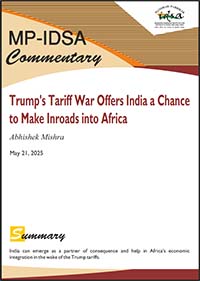Trump’s Tariff War Offers India a Chance to Make Inroads into Africa
- May 21, 2025 |
- IDSA Comments
Most African nations do not export much into the American market. US–Africa trade has been regularly shrinking, accounting for no more than 5 per cent of the total African trade. Africa is far more exposed to trade with China. Analysts note that the Trump administration’s logic of imposing ‘reciprocal’ tariffs based on bilateral trade deficits is obnoxious and is neither grounded on sound economic theory or trade law.[i] Countries like Lesotho (50 per cent), Madagascar (40 per cent), Botswana (37 per cent), Angola (32 per cent), Libya (31 per cent) and Algeria (30 per cent) are projected to be hit the hardest.
Ironically, these same countries which are listed among the “worst offenders” in trade relations will be shielded from the full blow of the tariffs. The reason being the policy currently exempts export of oil and gas and export of critical minerals like cobalt, lithium, nickel, copper, coal, gold, manganese, among others.[ii] So, Africa’s two largest economies—South Africa and Nigeria—exporting critical minerals and crude petroleum to the US respectively, will be shielded from the tariffs. Those nations which export apparel products to the US market like Lesotho and Madagascar are expected to be affected badly. But the larger issue over tariffs is that Africa’s only exclusive trade preferential programme, the AGOA, which is up for renewal in September 2025, is effectively dead.[iii]
New Wave of Protectionism: Vulnerability and Opportunity to Diversify
Africa finds itself amid this new wave of protectionism trying to balance vulnerability and a historical opportunity. That opportunity is being able to diversify its export markets, accelerate intra-African trade under the African Continental Free Trade Area (AfCFTA) and assert itself as an autonomous actor in the reshaping of global trade rather than as a mere battleground for great-power competition.
So far, the African response to Trump’s trade war has been uncoordinated. While some countries have folded fast and dropped tariffs on US products in the hope of staying in America’s good graces, others have rejected the pressure and called out Washington’s economic bullying. African countries may or may not impose retaliatory tariffs but at this juncture, they are hoping to negotiate bilateral deals for their countries.
While the direct economic impact of tariffs on African economies may be limited, a tit-for-tat tariff war between the US and China could potentially derail the global economy resulting in reduced demand for African raw materials. Less revenue for resource-intensive African economies will further strain government budgets. In the coming months, the cost of finance is only going to increase, making it difficult for Africa to finance its development, attract FDI or build the infrastructure it requires to become more competitive.
Declining trade between the US and China could result in a situation in which large quantities of Chinese goods are available in international markets, including in Africa, owing to Beijing’s excess manufacturing capacity. This could potentially undercut African producers and make the continent a dumping-ground for cheap Chinese-manufactured goods. Reports note that from 2002 to 2023, Africa’s trade deficit with China has grown from US$ 2.31 billion to US$ 82.68 billion.[iv] This reflects a surge in import of Chinese products among African nations.
Due to the current US–China trade war, there is a real risk of Africa’s manufacturing base getting undermined which could further constrain the continent’s industrial development journey. Unlike with China, Africa’s trade with the US has evolved in a positive direction which subsequently underscores “the potential benefits of preferential trade frameworks like the AGOA”.[v]
This puts Africa in a very tricky situation. While some nations may feel they can engage more satisfactorily with Washington, others may want to move closer to Beijing. Consequently, African leaders may be coerced to do exactly what they have feared for a long time—picking a side between the US and China. Without a common, unified African approach, initiatives like the AfCFTA which seeks to harmonise trading regulations and promote intra-Africa trade, risk being undermined. At this critical juncture, however, the main question is—Can African nations move beyond passive observations and undertake strategic recalibration?
Where India Comes into the Picture
The answer lies in the imperative for Africa to undertake strategic recalibration towards new trade partners like India. The tariffs highlight the need for African countries to diversify their export basket and invest more into building regional value chains. This is where Indian private sector with its long-term presence, familiarity of African markets and acceptability is presented with a good opportunity to play a more constructive role. However, the trade needs to be well-serviced with appropriate financial instruments if India’s trade volumes with Africa are to grow.
Currently, India is Africa’s fourth-largest trading partner. In 2024, total trade was valued at US$ 83 billion with Indian exports to Africa comprising US$ 45 billion and imports at US$ 38 billion.[vi] Indian investors are increasingly viewing Africa not just as a destination for short-term returns, but also as a partner for medium and long-term economic growth.[vii] The value addition of African products will help to integrate African nations into the Global Value Chains (GVC) and will give the continent an added edge.
India is placed favourably to help African countries process primary commodities like gold, diamond, raw cocoa, and add value to them and subsequently become a crucial partner in helping African nations market such resources. Indian private sector should seek to set up more manufacturing bases in various African countries.[viii] This would help to understand the specific requirements of African countries which are envisaged in the African Union’s Agenda 2063 document. Catering to local needs and generating employment opportunities is the broader goal.
On 15 April 2025, ‘Bharat Africa Setu’ initiative was launched by DP World and the Government of India which aims to provide Indian businesses access through sea and air connectivity between ports, economic zones and logistics parks across Africa.[ix] The goal is to create a holistic trading ecosystem between Africa and India by combining efficient physical infrastructure with value-added services. Such initiatives will also facilitate ease in compliance with regulatory processes, licensing requirements, and projects a 12 per cent growth in share of the Indian export economy by 2030.
Furthermore, on 23 April 2025, India and the South African Customs Union (SACU) bloc, comprising South Africa, Namibia, Botswana, Eswatini and Lesotho, renewed their negotiations for a preferential trade agreement (PTA).[x] South Africa’s reluctance to conclude an FTA even at the SACU level is a major obstacle due to Pretoria viewing its economy to be as competitive as India’s. It also holds ambivalent feelings about India in Africa as it welcomes India for ICT and human resource development but not much else. From April 2001 onwards, India already has a Comprehensive Economic Cooperation and Partnership Agreement (CECPA) with Mauritius and is also exploring the possibility of concluding a FTA with the AfCFTA in the near future.
As African countries attempt to reorganise and take an ‘Africa-first’ approach in their response to Trump’s tariffs, India with its longstanding partnerships is presented with a good opportunity to help in Africa’s economic integration and emerge as a partner of consequence.
Views expressed are of the author and do not necessarily reflect the views of the Manohar Parrikar IDSA or of the Government of India.
[i] Kevin Corinth and Stan Veuger, “President Trump’s Tariff Formula Makes No Economic Sense: It’s Also Based on An Error”, The American Enterprise Institute, 4 April 2025.
[ii] Hannah Ryder, Trevor Lwere and Ovigwe Eguegu, “How Should Africa Respond to Trump’s New Tariffs?”, Center for Strategic & International Studies, 8 April 2025.
[iii] Daniel F. Runde, “The AGOA Ship is Sinking: Congress Must Act Now to Save It”, Center for Strategic & International Studies, 20 December 2024.
[iv] Marvellous Ngundu, “The US-China Trade War and Africa’s Manufacturing Crossroads”, The Institute for Security Studies, 24 April 2025.
[v] Ibid.
[vi] “Text of the Vice-President’s Address at 19th CII India-Africa Business Conclave”, Press Information Bureau, Vice President’s Secretariat, Government of India, 21 August 2024.
[vii] Abhishek Mishra, “The African Continental Free Trade Area and Its Implications For India-Africa Trade”, Observer Research Foundation, 8 October 2018.
[viii] Abhishek Mishra, “Elevating The India-Africa Partnership to New Horizons”, Observer Research Foundation, 22 July 2022.
[ix] “DP World Announces Bharat Africa Setu With The Aim Of Doubling India-Africa Trade”, DP World, 15 April 2025.
[x] Shreya Nandi, “India, South Africa Discuss Preferential Trade Pact Through SACU Bloc”, Business Standard, 19 May 2025.





